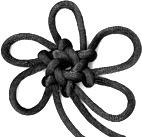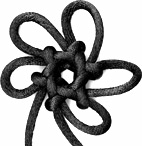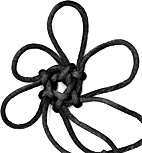Blogiversary Knot Prototyping
With those nice hexagonal beads, I wanted to frame them with a hexagonal knot. It didn’t need to be particularly stable as I’d be reinforcing the central area with thread (and more beads), so likely I’d be taking a hexagonal knot and reduce the amount of overlapping an favour of a bigger centre hole, the better to display the framed bead rather than hide it. Looking through Lydia Chen’s third book, I decided on the “Type 2 Compound Constellation Knot” which unlike your basic hexagonal stellar knot (which is uouu) has a structural loop path of uuouo. At this point I’ve tied it about 6-7 times and each time it looks… funny. As usual with a new polygonal knot, it’s the last interlacing pass on the back side that’s tricky.

 Frustrated, I decided to go back to basics. Start with a basic hexagonal stellar knot (left, the “Constellation Knot with Five Outer Loops” in the book). It works as expected (yay!) and I get a feel for the issues with tightening a stellar knot. Using the structural loop path of the pentagonal stellar knot (uou), I tied a new hexagonal stellar knot (right). It works well, and if I can’t get the kinks out of type 2 this will definitely be the bead framing knot.<br clear=”all”
Frustrated, I decided to go back to basics. Start with a basic hexagonal stellar knot (left, the “Constellation Knot with Five Outer Loops” in the book). It works as expected (yay!) and I get a feel for the issues with tightening a stellar knot. Using the structural loop path of the pentagonal stellar knot (uou), I tied a new hexagonal stellar knot (right). It works well, and if I can’t get the kinks out of type 2 this will definitely be the bead framing knot.<br clear=”all”
 Heartened by success, I decide to try good ole type 2 one more time. As usual, everything goes well until the last pass on the reverse side. It’s confusing and just never looks right (see left). Finally, I pick a path, call it done and try tightening it. Sadness. Even if I’ve tied it right, it doesn’t tighten up in a way that looks right.
Heartened by success, I decide to try good ole type 2 one more time. As usual, everything goes well until the last pass on the reverse side. It’s confusing and just never looks right (see left). Finally, I pick a path, call it done and try tightening it. Sadness. Even if I’ve tied it right, it doesn’t tighten up in a way that looks right.
I’m going to give it one more try. This time with a shoelace so that there is no doubt about the structure.